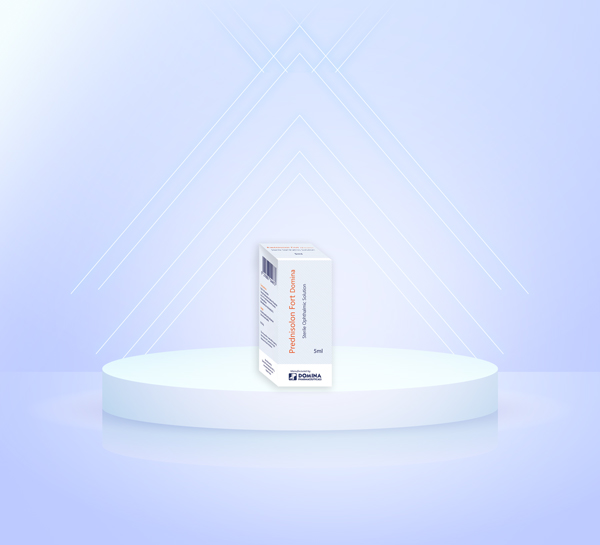
Composition: Each 1ml ophthalmic solution contains 10mg Prednisolone Sodium Phosphate (equivalent to 9.1mg Prednisolone Phosphate)
Excipients: Benzalkonium chloride solution, Hypermellose, sodium chloride, sodium acid phosphate, sodium edentate, sodium hydroxide, Hydrochloric Acid and purified water.
Clinical Pharmacology
Prednisolone sodium phosphate causes inhibition of inflammatory response to inciting agents of mechanical, chemical, or immunological nature.
Indications:
Prednisolon Fort Domina is for the treatment of steroid responsive inflammatory conditions of the palpebral and bulbar conjunctiva, cornea, and anterior segment of the globe, such as allergic conjunctivitis, acne rosacea, superficial punctate keratitis, herpes zoster keratitis, iritis, cyclitis, selected infective conjunctivitis when the inherent hazard of steroid use is accepted to obtain an advisable diminution in edema and inflammation, corneal injury from chemical, radiation, or thermal burns, or penetration of foreign bodies.
Prednisolon Fort Domina is recommended for moderate to severe inflammations, particularly when unusually rapid control is desired. In stubborn cases of anterior segment eye disease, systemic adrenocortical hormone therapy may be required. When deeper ocular structures are involved, systemic therapy is necessary.
Contraindications:
The use of this Product is contraindicated in the presence of:
- Acute superficial herpes simplex keratitis.
- Fungal diseases of ocular structures.
- Acute infectious stages of vaccinia, varicella and most other viral diseases of the cornea and conjunctiva.
- Tuberculosis of the eye.
- Hypersensitivity to a component of this medication.
- The use of this preparation is always contraindicated after uncomplicated removal of a superficial corneal foreign body.
Warnings:
- FOR TOPICAL USE ONLY
- Employment of steroid medication in the treatment of herpes simplex keratitis involving the stroma requires great caution; frequent slit-lamp microscopy is mandatory.
- Prolonged use may result in elevated intraocular pressure and/or glaucoma, damage to the optic nerve, defects in visual acuity and fields of vision, posterior subcapsular cataract formation, or may aid in the establishment of secondary ocular infections from pathogens liberated from ocular tissues. In those diseases causing thinning of the cornea or sclera, perforation has been known to occur with the use of topical steroids.
- Acute purulent untreated infection of the eye may be masked or activity enhanced by presence of steroid medication. Viral, bacterial, and fungal infections of the cornea may be exacerbated by the application of steroids.
- This drug is not effective in mustard gas keratitis and Sjِgren’s keratoconjuncitivitis. If irritation persists or develops, the patient should be advised to discontinue use and consult prescribing physician.
- Do not touch dropper tip to any surface as this may contaminate the solution.
- As fungal infections of the cornea are particularly prone to develop coincidentally with long-term steroid applications, fungus invasion must be suspected in any persistent corneal ulceration where a steroid has been used or is in use.
- Intraocular pressure should be checked frequently.
Adverse Reactions:
Glaucoma with optic nerve damage, visual acuity and field defects, posterior subcapsular cataract formation, secondary ocular infections from pathogens including herpes simplex and fungi, and perforation of the globe.
Rarely, filtering blebs have been reported when topical steroids have been used following cataract surgery.
Rarely, stinging, or burning may occur.
Pregnancy:
Animal reproductive studies have not been conducted with prednisolon Fort Domina. It is also not known whether prednisolone can cause fetal harm when administered to a pregnant woman or can affect reproductive capacity. prednisolon Fort Domina should be given to a pregnant woman only if clearly needed.
Lactation:
It is not known whether this drug is excreted in human milk. Because many drugs are excreted in human milk, caution should be exercised when prednisolon Fort Domina is administered to a nursing woman.
Dosage and Administration
Depending on the severity of inflammation, instill one or two drops of prednisolon Fort Domina into the conjunctival sac up to every hour during the day and every two hours during the night as necessary as initial therapy.
When a favorable response is observed, reduce dosage to one drop every four hours.
Later, further reduction in dosage to one drop three to four times daily may suffice to control symptoms.
The duration of treatment will vary with the type of lesion and may extend from a few days to several weeks, according to therapeutic response. Relapses, more common in chronic active lesions than in self-limited conditions, usually respond to retreatment.